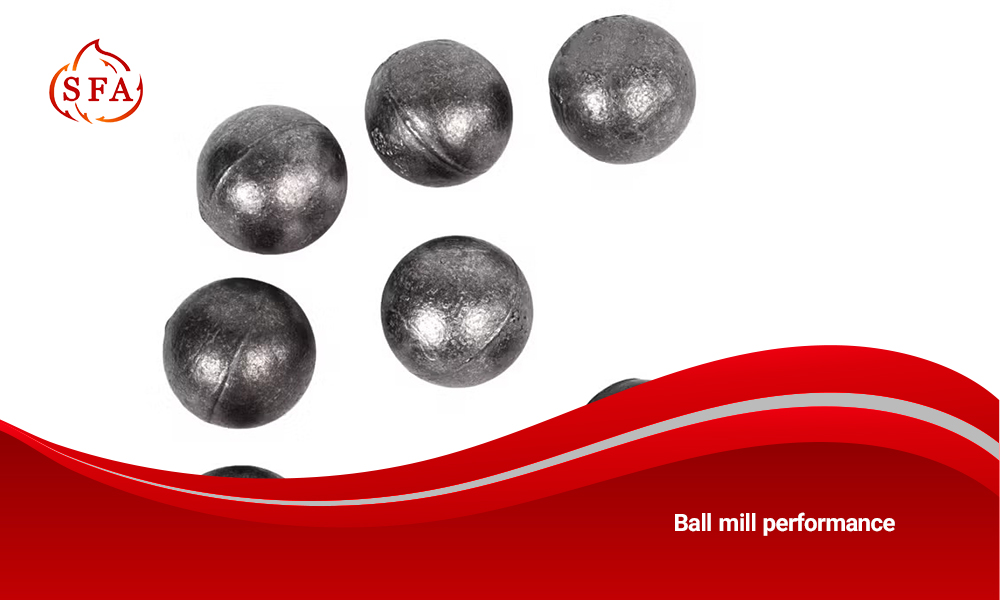

How to improve ball mill performance with suitable grinding balls?
The correct selection of grinding balls (abrasive media) is of great importance in improving the efficiency of ball mills. Ball mills are one of the key grinding equipment in various industries, including cement, mining and thermal power plants. Reducing energy consumption, increasing efficiency and stable production quality are the results of using appropriate abrasive media. For example, selecting the right grinding balls increases grinding efficiency and significantly lowers consumption and energy costs. The quality and choice of balls also determine how efficiently energy transfers to the materials, the speed and uniformity of grinding, and the final product’s quality.
For example, as one study has shown, “optimal selection of abrasive media leads to reduced energy and material consumption; durable media with high wear and impact resistance have a longer life and reduce the costs of the grinding process . In the following, we will discuss important technical aspects related to the abrasion resistance and hardness of the balls, grinding efficiency, energy savings, cost reduction, and production sustainability, and provide examples of the application of suitable balls in Atashgah Steel Mills. the cement, mining and power plants industries.
The importance of abrasion resistance and hardness of grinding balls
An ideal grinding ball is hard enough to resist wear but flexible enough to prevent sudden breakage. Increasing hardness generally reduces wear, but balancing hardness and malleability (resistance to impact) is essential. Choosing the right alloy is also crucial. For example, high-alloy white cast iron (HCCI) balls contain 11–35% chromium and 1.8–7.5% carbon. These elements form numerous hard carbides, giving the balls excellent wear resistance. Research shows that in dry applications, HCCI balls wear up to ten times slower than conventional steel balls.
For this reason, hard and corrosive industries – such as hard rock quarries, cement mills and thermal power plants (coal mills) – use high chromium balls to increase ball life and reduce cost fluctuations. On the other hand, steel (forged) balls are more common and cheaper but wear out faster in severe abrasive conditions. However, when product contamination is not a concern and the initial cost matters, manufacturers use carbon steel or high-speed steel balls. In short, (good media should have high hardness, wear resistance and corrosion resistance but at the same time a good percentage of flexibility)
Increasing mill efficiency and saving energy
The correct selection of grinding balls has a direct impact on the efficiency of the ball mill and energy consumption. In general, increasing the contact between the balls and material particles reduces the energy needed for grinding and produces a coarser, more uniform final product. According to research, (the appropriate selection of grinding media reduces energy and material consumption.) Studies show that the type of grinding media significantly affects energy transfer to particles and influences the speed and uniformity of size reduction. Energy consumption in ball mills also directly depends on the total weight of the balls. In other words, very heavy media, although they have greater grinding power, require more kinetic energy to rotate the grinding cylinder.
Therefore, a balance must be struck between the size and weight of the balls. For example, larger balls are suitable for grinding coarse materials, but may produce a coarser end product and require more energy, while smaller balls increase the size reduction rate but require more time and energy. From a numerical perspective, the majority of the operating costs of a ball mill are energy. One study showed that approximately 50% of the costs are related to energy consumption and about 37% are related to media replacement. Therefore, by improving the selection of balls and using more efficient media, one can see a significant reduction in energy consumption and ancillary costs.
Cost reduction and production stability
The use of high-quality grinding balls that are compatible with the process conditions can significantly reduce production and maintenance costs. In fact, as mentioned, “grinding media is one of the most expensive consumables in the grinding process after energy.” Therefore, reducing the wear rate of the balls and increasing their lifespan directly reduces the total cost of operation. For this purpose, media with a lower wear rate are preferred. Because “media with a lower wear rate have a longer life and produce fewer worn parts.” In addition, the cost of replacement and downtime due to replacement are reduced.
In addition, production stability is also improved by the correct selection of media. Durable balls exert a more uniform working pressure on the material, resulting in less unexpected variations in mill output and a more homogeneous final product. In the following real-world examples, we will point out how various industries have been able to maintain consistent production quality by using the right media.
Click to read the article «Improving Mining Mill Efficiency with Premium Cast Balls».
Industrial examples: cement, mining, and power plants
- Cement industry: Cement mills typically use high-wear steel and cast iron balls to grind clinker. As the balls wear out, grinding effectiveness decreases, which can lead to reduced efficiency and increased energy consumption. For example, one industry source says, “As the life of the balls decreases, their effectiveness in grinding decreases, which can lead to reduced efficiency and output and increased energy consumption.” The use of high-chromium alloy balls is common in this industry; as mentioned, studies show that chromium-containing white cast iron balls are up to 10 times less abrasive in dry operations. This not only reduces overhead costs, but also ensures consistent production and consistent cement quality
- Mining industry: Ball mills play a major role in the crushing of hard ore. For example, in metal mines, ball mills are used as secondary or reciprocating crushing stages. In such applications, the choice of media directly affects metal recovery and energy costs. As a report from the Mining Industry notes, “Ball mill efficiency directly affects the cost of the entire mining process, and grinding media plays a very important role in increasing mill efficiency.” Thus, the use of lighter, harder, and highly impact-resistant balls can increase crushing rates and reduce energy consumption.
- Thermal power plants: In hydro and thermal power plants, ball mills are used to grind coal. High-wear chromium and steel balls are usually chosen for this application. The importance of uniform particle size in the boiler inlet for optimal combustion has made the quality of the grinding media important. Relevant studies have shown that high-quality media in the power plant leads to stable gas fuel flow and reduces the risk of unwanted shutdowns. In addition, the use of suitable balls in coal mills in power plants leads to “significant energy savings” and reduced pollutant emissions.
Comparison of common types of grinding balls and features
| Ball Type | Properties (Composition & Hardness) | Advantages and Applications |
| Carbon Steel (Forged Steel) | Medium hardness steel alloy (around 55–60 HRC) | Low initial cost, suitable for coarse grinding; commonly used in cement plants and primary mineral grinding. |
| Manganese Steel | Steel–manganese alloy with high hardness after work hardening | Good impact resistance, ideal for high-pressure mills; used in mining operations (SAG/AG Mills). |
| High Chrome White Cast Iron (HCCI) | Contains 12–30% Chromium and 1.8–7.5% Carbon, very high hardness (>62 HRC) | Excellent wear and corrosion resistance, long service life, ideal for abrasive and corrosive conditions in mining and power plants. |
| Ceramic Balls (Alumina/Zirconia) | Extremely high hardness (>65 HRC) and high specific gravity | Highly resistant to wear and chemical contamination; limited use in sensitive materials (pharmaceutical/food industries); very long lifespan. |
This table shows that each type of ball is suitable for a specific application, depending on its composition and hardness. For example, high-chromium cast iron, with its high resistance, is used in severe abrasive environments and increases the life of the balls, while steel balls are economical in terms of initial cost but require frequent replacement.
Conclusion
Improving ball mill performance is directly related to the correct selection of grinding balls. Selecting the right grinding media for hardness, wear resistance, and weight increases grinding efficiency. It also reduces energy consumption, stabilizes production, and optimizes costs. Experience in the cement, mining, and power plant industries shows that using high-chromium or optimized alloy balls extends mill life and maintains product uniformity. To achieve the best ball mill performance, operators must carefully balance the balls’ material, size, and hardness. This ensures effective energy transfer, reduces wear, and maintains stable production.
Finally, consulting with experienced professionals and the Sepahan Foolad Atashgah Commercial Manager can play a decisive role in increasing efficiency and economic savings in selecting the right balls for any type of industrial application.


